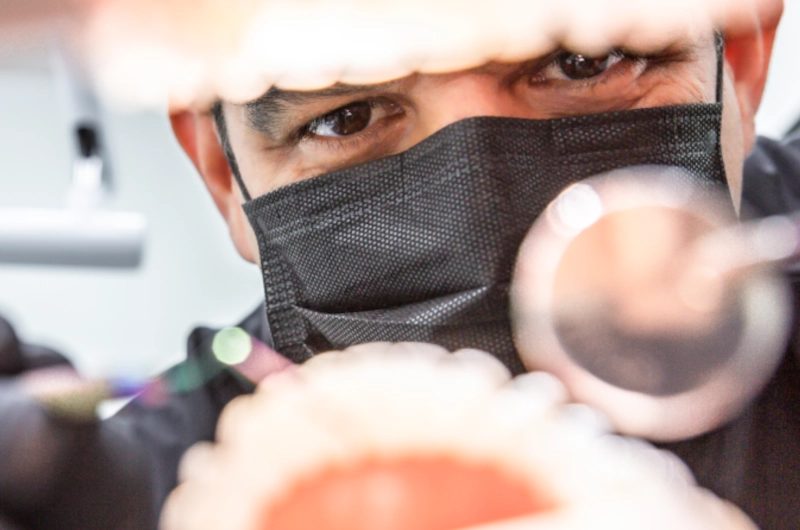Dental implantology

Getting Your Smile and Confidence Back
Dental implantology is a dental specialty dedicated to the placement of dental implants, which are biocompatible titanium structures designed to replace the roots of lost teeth. These implants integrate with the maxillary or mandibular bone, providing a solid and stable base for the placement of crowns, bridges or dental prostheses.
When are Dental Implants Necessary?
Dental implants are an excellent option to replace one or more teeth lost due to tooth decay, periodontal disease, trauma or any other cause. They are especially recommended for people looking for a long-lasting, aesthetic and functional solution to restore their smile and improve their quality of life.
Benefits of Dental Implants:
- Natural aesthetics: Dental implants and the crowns or dentures placed on them mimic the appearance of natural teeth, both in shape and color, providing an aesthetically pleasing and natural smile.
- Function and comfort: Dental implants integrate with the bone, allowing them to function like natural roots, providing a solid foundation for normal chewing and speaking. They also do not slide or move around in the mouth, increasing patient comfort and confidence.
- Durability: Dental implants are a long-term solution, as titanium is a biocompatible and corrosion-resistant material. With proper care, implants can last a lifetime.
- Bone preservation: Dental implants stimulate the maxillary or mandibular bone, preventing bone loss that often occurs after tooth loss.
- Improved self-esteem: Restoring your smile with dental implants can significantly improve a patient’s self-esteem and confidence, allowing them to smile, speak and eat without worry.
The Implantology Process Step by Step:
- Evaluation and planning: The implantologist will perform a thorough examination, including x-rays and CT scans, to assess the amount and quality of available bone and determine the appropriate type and size of implants.
- Implant placement: The implant is placed in the maxilla or mandibular bone in an outpatient surgery under local anesthesia. Recovery time varies from case to case, but is generally quick and uncomplicated.
- Osseointegration: Over the next few months, the implant fuses with the bone in a process called osseointegration. This process is essential to ensure the stability and durability of the implant.
- Placement of the abutment: Once the implant has integrated with the bone, an abutment is placed on it, which will serve as a connection between the implant and the crown or dental prosthesis.
- Placement of the crown or prosthesis: Finally, the crown or dental prosthesis is placed on the abutment, restoring the function and aesthetics of the lost tooth.
Aftercare:
To ensure the long-term success of dental implants, it is essential to maintain good oral hygiene, brush and floss regularly, and have regular check-ups with your implantologist.
Dental implantology is a safe and effective option to replace missing teeth and restore function, aesthetics and confidence in your smile. If you are considering dental implants, consult with a qualified implantologist to evaluate your case and determine if you are a suitable candidate for this treatment.
Frequently Asked Questions
Will getting a smile design damage my teeth?
Smile Design does not necessarily involve damage to teeth. Modern dentistry focuses on being as minimally invasive as possible, seeking to preserve the natural structure of teeth as much as possible. The current philosophy is oriented towards a conservative approach, where tooth wear is avoided whenever possible. This change in dental practice arises from the advancement in the techniques and materials used, which allow for improved dental aesthetics without compromising underlying dental health.
With the use of ultra-thin veneers, for example, the requirement for tooth preparation is minimized, thus preserving the integrity of the tooth. The idea is to improve the smile without sacrificing tooth structure, which is a critical consideration for many patients interested in this procedure. Therefore, it is crucial to choose a specialist dentist in ORLANDO FLORIDA with experience who applies the most advanced and minimally invasive techniques.
How long does it take to get a smile design?
The durability of a Smile Design depends on multiple factors, including the type of procedure performed, the materials used, and the patient’s dental care habits.
However, longevity also depends on the patient’s maintenance and hygiene habits. Attending regular dental checkups, maintaining good oral hygiene, and avoiding harmful habits such as biting on hard objects can significantly contribute to the durability of the treatment. It is important to remember that although the materials used in Smile Design in ORLANDO FLORIDA are of high quality, aftercare plays a crucial role in preserving the results.



